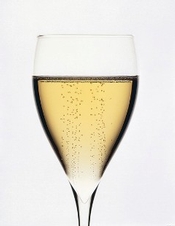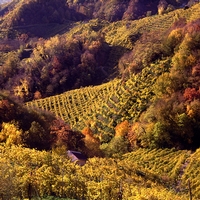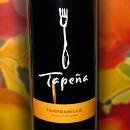|
|
 |
|
March 31, 2010
It’s no joke. Effective April 1st, Prosecco, the increasingly popular but often very simple-tasting Italian fizz, will be elevated to DOCG status, placing it on the same level as Italy’s most prestigious wines. No fooling -- from now on Prosecco will be playing in the same league as Barolo, Brunello, Chianti Classico and the other Italian elites. placing it on the same level as Italy’s most prestigious wines. No fooling -- from now on Prosecco will be playing in the same league as Barolo, Brunello, Chianti Classico and the other Italian elites.
Of course, that same league also includes wines such as Albana di Romagna, Cesanese del Piglio, Sforzato di Valtelina, and a host of others that even the most avid connoisseur would not likely consider the cream of the Italian crop. No one has ever accused authorities in Rome of using logic when identifying DOCG and DOC wines. And it’s important to understand that not all Prosecco will gain DOCG status. Only wines made in the Conegliano e Valdobbiadene zone in the province of Trevisio will merit the distinction.
The rationale for this change, long advocated by the producers’ consortium in Conegliano e Valdobbiadene, is to distinguish authentic, artisanal Prosecco from the sea of more industrial wine on the market. As Giancarlo Vettorello, the consortium’s director, explains, the goal was to create a “quality pyramid” for consumers, with more generic Prosecco at the base, and the best wines at the top.
The problem is that, both in terms of production volume and in terms of point of origin, this pyramid’s base is immense. The new regulations establish a massive DOC zone for Prosecco at large. This newly delimited region includes much of the Veneto and most of Friuli-Venezia Giulia, going all the way to the Slovenian border. The wines made in it clearly threaten to overwhelm the small peak of quality at the top. Moreover, that peak does not simply include wines from one place. The distinction between a first-rate Prosecco and an ordinary one is not necessarily geographical. With this particular bubbly, neither authenticity nor quality is just a matter of locale.
There can be no doubt that the finest Conegliano e Valdobbiadene  Proseccos, particularly those made from grapes grown on the Cartizze hill (the one location that pretty much everyone agrees does merit special recognition), are superlative wines. Customarily off-dry, with pronounced fruit flavors (think pineapple, peach, apple, even banana, in addition to citrus), their focused acidity gives them impressive harmony and balance. At the same time, however, a great deal of Prosecco tastes sugary but charmless. And while tanker trucks full of it come from outside the Conegliano e Valdobbiadene zone, you can find plenty of disappointing wine made from grapes grown within the new DOCG. Proseccos, particularly those made from grapes grown on the Cartizze hill (the one location that pretty much everyone agrees does merit special recognition), are superlative wines. Customarily off-dry, with pronounced fruit flavors (think pineapple, peach, apple, even banana, in addition to citrus), their focused acidity gives them impressive harmony and balance. At the same time, however, a great deal of Prosecco tastes sugary but charmless. And while tanker trucks full of it come from outside the Conegliano e Valdobbiadene zone, you can find plenty of disappointing wine made from grapes grown within the new DOCG.
That’s why the proverbial jury remains out on the question of whether the new designations represent a change for the better. A great deal of today’s Conegliano e Valdobbiadene Prosecco, even the more expensive and so allegedly prestigious bottlings, are blends of wines made from grapes grown throughout the zone. Perhaps in the future more of them will come from specific locales and so taste more distinctive. But it seems just as likely that the new designation will embolden producers to raise prices without significantly improving the wines. And if that happens, consumers will be the ones being played for this April’s fool.
Posted by Paul Lukacs at 11:04 AM
|
|
March 24, 2010
 There was a time, not that many years ago, when a brash young winemaker at Hahn Estates ruled the wine competition world from Los Angeles to London. There was a time, not that many years ago, when a brash young winemaker at Hahn Estates ruled the wine competition world from Los Angeles to London.
Under the skillful direction of Adam LaZarre, the Monterey County winery scored major trophies at big wine competitions around the globe. And they did it with modestly priced wines, such as a $16 Cabernet Sauvignon, a $14 Merlot and a red Bordeaux-style blend for less than $20.
For a time, it seemed a week couldn't go by without a LaZarre-inspired wine winning best of show in Los Angeles or San Francisco or London, or some other important wine competition venue. LaZarre is no longer at Hahn, having moved 75 miles down U.S Highway 101 to Paso Robles, where he is running the promising start-up winery Villa San-Juliette. He also makes a number of wines under his own LaZarre label.
He may have moved, but LaZarre hasn't changed all that much. He's still brash, still prolific, and Sunday afternoon he returned to the winner's circle at the 27th annual San Diego International Wine Competition.
"I'm back!" LaZarre exclaimed as it was revealed that his 2007 Central Coast LaZarre Pinot Noir ($35) had been voted Best Red Wine of the show. It was no small feat. Among the contenders for best red honors were the 2006 ZD Reserve Napa Valley Cabernet Sauvignon ($125), the 2007 Bell Clone 6 Napa Valley Cabernet Sauvignon ($90) and the 2007 Spoto Napa Valley Syrah ($70), platinum award-winners all.
 The venerable SDIWC attracted nearly 2,000 entries, bestowed more than 1,000 medals and crowned five best of show winners, including the LaZarre Pinot. Value-seeking consumers should be encouraged to note the 31 judges — winemakers and wine industry professionals — handed out one of the top awards, best of show sparkling, to the relatively inexpensive Korbel Brut Rose ($11). The sleek 2004 Domaine Carneros Le Reve Blanc de Blancs ($85) was in the running for the top honor, but the judges opted instead for the refreshing, bright berry fruit of the Korbel bubbly. The venerable SDIWC attracted nearly 2,000 entries, bestowed more than 1,000 medals and crowned five best of show winners, including the LaZarre Pinot. Value-seeking consumers should be encouraged to note the 31 judges — winemakers and wine industry professionals — handed out one of the top awards, best of show sparkling, to the relatively inexpensive Korbel Brut Rose ($11). The sleek 2004 Domaine Carneros Le Reve Blanc de Blancs ($85) was in the running for the top honor, but the judges opted instead for the refreshing, bright berry fruit of the Korbel bubbly.
Other best-of-show winners included the 2008 V. Sattui Early Harvest White Riesling ($18.75) as best white, the 2008 Penman Springs Two Roses Syrah Rose ($15) as best rose, and the 2008 Hazlitt 1852 Vineyards Finger Lakes Vidal Blanc Ice Wine ($40 per half bottle) as best dessert.
Click here for complete SDIWC results.
Posted by Robert Whitley at 9:02 AM
|
|
March 9, 2010
 It has become a Wine Talk column tradition that following every Monterey Wine Competition since its inception in 1994 I devote part of an ensuing column to selected value gold medal wines. It has become a Wine Talk column tradition that following every Monterey Wine Competition since its inception in 1994 I devote part of an ensuing column to selected value gold medal wines.
The 17th annual Monterey Wine Competition was staged March 6-7 at the Salinas Valley Fairgrounds in King City, CA. Here are the highlights from this week's nationally syndicated Creators Syndicate Wine Talk column:
EOS Estate Winery 2007 French Connection, Paso Robles ($18) — This red Bordeaux-style blend from the up-and-coming Paso Robles region is a steal in this price range. It was nominated for the sweepstakes round of voting for Best of Show, and thus was elevated from gold to platinum.
Ventana Vineyards 2007 Rubystone, Arroyo Seco ($18) — Another gold that was elevated to Platinum as a result of being nominated for Best of Show consideration. This red Rhone-style blend is heavy on the Grenache, which lends a pure red-fruit aroma profile. The scent of white pepper is unmistakable and very sexy. The previous vintage of Rubystone also earned gold and made it to the sweepstakes of the 2009 Monterey Wine Competition.
 Castello Banfi 2008 Centine Bianco, Toscana ($12) — This blend of Pinot Grigio, Sauvignon Blanc and Chardonnay is a sensational everyday white, delivering refreshing and complex flavors at a low, low cost. Castello Banfi 2008 Centine Bianco, Toscana ($12) — This blend of Pinot Grigio, Sauvignon Blanc and Chardonnay is a sensational everyday white, delivering refreshing and complex flavors at a low, low cost.
Lava Cap 2007 Barbera Reserve, El Dorado ($18) — The wines of California's Sierra Foothills aren't the easiest to find, but they are certainly worthy of the effort to seek them out. This one's great for grilled meats with savory seasonings or with flavorful pasta dishes.
Little Black Dress 2007 Cabernet Sauvignon, California ($11) — It's a feat to be able to tantalize the taste buds with a mass-produced commercial Cabernet, but Little Black Dress pulls it off consistently. If you're on a tight budget, this is a great Cab for the money. PS: At the same price, the Little Black Dress 2008 Chardonnay also earned Platinum!
Villa San-Juliette 2007 Cabernet Sauvignon, Paso Robles ($15) — Dollar for dollar perhaps the best value in red wine I encountered at this year's Monterey competition. The winemaker, Adam LaZarre, is a rising star and his wines at Hahn Estates, his previous stop, were stellar over the better part of his decade there. This one was elevated to Platinum by virtue of its presence in the sweepstakes round.
 Fleur de California 2007 Pinot Noir, Carneros ($17) — You simply don't find many gold medal Pinots for less than $20 a bottle. Or even $30 a bottle. So this wine stands out on the merits and the price. Get it while it lasts. Fleur de California 2007 Pinot Noir, Carneros ($17) — You simply don't find many gold medal Pinots for less than $20 a bottle. Or even $30 a bottle. So this wine stands out on the merits and the price. Get it while it lasts.
Fish Eye 2007 Pinot Noir, South Eastern Australia ($7) — See the above!
Jefferson Vineyards 2008 Petit Verdot, Virginia ($19) — I realize this wine from southern Virginia will be nearly impossible to source unless you are visiting the Charlottesville area for some reason, but I mention it because the panel that judged it loved it, and one even pegged it for a Virginia wine.
Segura Viudas 2003 Mas d'Aranyo Tempranillo, Penedes ($15) — We've been saying for some time that Spain is home to many of the greatest values in collectible red wine. I would be proud to have several bottles of this wine in my cellar — in fact, I do.
 Tapena 2008 Tempranillo, Tierra de Castilla ($10) — These guys in the unregulated region of La Mancha are doing a fabulous job with huge volumes of Spanish reds and whites. You cannot only afford them, but they're also delicious! Tapena 2008 Tempranillo, Tierra de Castilla ($10) — These guys in the unregulated region of La Mancha are doing a fabulous job with huge volumes of Spanish reds and whites. You cannot only afford them, but they're also delicious!
Domaine Ste. Michelle Brut, Columbia Valley ($13) — In the world of inexpensive bubbly, this non-vintage beauty from Ste. Michelle is a standout. If you have a wedding or other large party planned for this spring and summer and hope to serve a good bubbly that won't break the bank, you could do way worse than this.
Navarro Vineyards 2008 Muscat Blanc, Anderson Valley ($19) — Though I know this wine would be difficult to find and Muscat, for some people, is a very hard sell, I am confident that no open-minded wine lover would fail to see the charms of this dry, well-balanced, floral beauty from one of California's most accomplished producers of aromatic white wines.
Click here for complete results of the 2010 Monterey Wine Competition
.
Posted by Robert Whitley at 4:21 PM
|
|
March 4, 2010
Saturday’s massive earthquake in Chile resulted in the deaths of at least 800 persons as well as terrible physical devastation. Chile’s wine industry was hit particularly hard, and early estimates indicate that losses run to nearly $1 billion in spilled wine alone. René Merino, president of Wines of Chile, pegged the losses at 150 million bottles worth of wine, though total losses may run much higher once the damage is assessed more precisely. At current retail prices in the United States (for which Chile is the fourth leading source of imported wine), the loss would be worth roughly $975 million--and that figure does not include extensive physical damage to wineries or vineyards.
Damage to facilities and irrigation systems seems to be most serious in the Maule, Colchagua and Cachapoal valleys. Much of the destruction resulted from the toppling of stainless steel fermenters and storage tanks, which appear to have crashed when legs snapped beneath the shaking, top-heavy tanks, which then took down adjacent vessels in a disastrous domino effect. Stacked casks and bottles were also smashed in many areas.
Vineyards have also been imperiled just as the 2010 harvest is beginning in earnest. Decades-old irrigation canals that channel run-off from the Andean snowpack to vineyard areas have collapsed or been severed. Within the vineyards, widespread power outages have deprived vintners of power for the drip irrigation systems that would carry essential moisture to the vines at this very hot point in the growing season. Back-up generators are in very short supply in the entire area south of Santiago, so damage to this year’s crop may add to the massive losses from last year’s harvest.
Posted by Michael Franz at 9:20 AM
|
|
 |
|